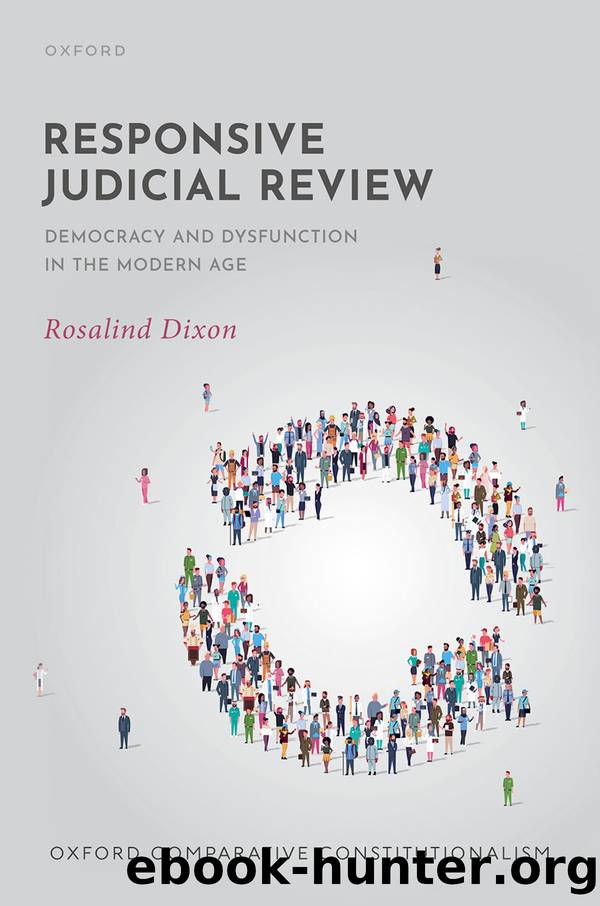Responsive Judicial Review by Dixon Rosalind;

Author:Dixon, Rosalind;
Language: eng
Format: epub
Publisher: Oxford University Press, Incorporated
Published: 2023-03-15T00:00:00+00:00
B. Countering Dysfunction
Constitutionalâor ultimate appellateâcourts worldwide have a range of different institutional features and powers. Some courts enjoy abstract powers of reviewâor powers to review legislation ex ante before it is enacted and not to consider its application or validity after enactment. This, for example, was the model of judicial review advocated by Hans Kelsen and then adopted in Austria in 1920.23 It also had important precursors in Latin America, in the actio popularis introduced in Colombia in 1910, and in Venezuela prior to 1920.24 And it was common in many European countries for much of the twentieth century.25 France only moved to adopt a mix of abstract and concrete review in 2008.26
Other courts conduct judicial review of legislation on a concrete or a posteriori basis. This is the dominant tradition of judicial review in the Anglo-American world and means that courts conduct processes of judicial review at the instigation of specific parties and in a way that involves the consideration of legislation as applied to particular concrete cases. An increasing number of courts worldwide also exercise both forms of reviewâoften through a combination of different procedures, or procedures that allow direct access by petitioners as well as access by way of a referral or appeal. In Colombia, for example, the Constitutional Court hears a mix of both constitutional appeals and individual âtutelaâ petitions brought directly by individuals.27 Similar forms of âamparoâ procedure also exist in Argentina, Brazil, Mexico, and several other Latin American jurisdictions.28
Another of Kelsenâs influences is that courts vary in the degree to which they are âspecializedâ versus âgeneralâ courts of appeal. Many countries now have some form of specialized constitutional court, with jurisdiction only in respect of constitutional matters.29 Others, however, have a general appeals court with jurisdiction in constitutional matters. There may be important differences in the training and background of judges on the two kinds of court. Judges on specialized courts may have a variety of backgrounds, including legislative and academic backgrounds, whereas judges in ordinary courts will tend to be former practicing lawyers or lower court judges.
This may also mean there are differences among courts in their ability to identify and counter different kinds of democratic pathology or blockage; the composition and caseload of specialized courts, for example, may make them better equipped to identify currents in democratic opinion that point to legislative burdens of inertia, whereas the background and jurisdiction of judges on ordinary courts may mean they are better positioned to identify certain kinds of legislative blind spot. Whether this is true will depend on whether the caseload of a constitutional court gives it a broad view of issues and attitudes within civil society without overwhelming its capacity to give the necessary careful and detailed attention to specific cases.
Similarly, courts exercising abstract forms of review may have the capacity to counter legislative inertia but more limited capacity than courts with concrete powers of review to assess the law in actionâas it applies to specific contexts and individualsâin ways that allow them effectively to identify and counter legislative blind spots.
Download
This site does not store any files on its server. We only index and link to content provided by other sites. Please contact the content providers to delete copyright contents if any and email us, we'll remove relevant links or contents immediately.
| Comparative | Conflict of Laws |
| Customary | Gender & the Law |
| Judicial System | Jurisprudence |
| Natural Law | Non-US Legal Systems |
| Science & Technology |
American Kingpin by Nick Bilton(3753)
Future Crimes by Marc Goodman(3519)
The Meaning of the Library by unknow(2503)
Inside the Middle East by Avi Melamed(2305)
Why Nations Fail: The Origins of Power, Prosperity, and Poverty by Daron Acemoglu & James Robinson(2233)
On Tyranny by Timothy Snyder(2174)
Living Silence in Burma by Christina Fink(2037)
Putin's Labyrinth(1957)
The Mastermind by Evan Ratliff(1897)
The Smartest Kids in the World by Amanda Ripley(1798)
Think Like a Rocket Scientist by Ozan Varol(1776)
Law: A Very Short Introduction by Raymond Wacks(1696)
It's Our Turn to Eat by Michela Wrong(1682)
The Rule of Law by Bingham Tom(1648)
Philosophy of law a very short introduction by Raymond Wacks(1621)
Leadership by Doris Kearns Goodwin(1595)
A Dirty War by Anna Politkovskaya(1579)
Civil Procedure (Aspen Casebooks) by Stephen C. Yeazell(1509)
Social Media Law in a Nutshell by Ryan Garcia & Thaddeus A Hoffmeister(1493)
